Most starter train sets come with a circle or oval of track. Don’t let that stop you from creating the railroad of your dreams
Lionel train sets usually come with an oval of Lionel FasTrack that includes eight 36 inch diameter curves, three 10 inch straight tracks, and one 10 inch terminal track that has wires to attach the power transformer (figure 1). We will use Lionel’s FasTrack for all the examples in this article, but similar layouts could be created using any other track system. Keep in mind even though we are working from what is included in a starter train set, that track is also included in the list of materials for each layout.

Figure 1: starter loop
Track
6-12015, 0 Lionel FasTrack, Curve 18″, angle 45º (O36) 8 pieces
6-12016, 0 Lionel FasTrack, Terminal section 10″ 1 piece
6-12014, 0 Lionel FasTrack, Straight 10″ 3 pieces
As we showed on our Simple 4 x 8 layouts, adding just a few pieces of track can add a lot to operational opportunities. One of the most common additions is a switch or turnout (figure 2) to create a place for your trains to deliver and pick up cars. This would require a few different pieces of track:

Figure 2: 1 inside siding
Track
6-12015, 0 Lionel FasTrack, Curve 18″, angle 45º (O36) 8 pieces
6-12014, 0 Lionel FasTrack, Straight 10″ 7 pieces
6-12016, 0 Lionel FasTrack, Terminal section 10″ 1 piece
6-12024, 0 Lionel FasTrack, Straight 5″ 1 piece
6-12035, 0 Lionel FasTrack, Buffer/Bumper (Light) 5″ 1 piece
6-81947, 0 Lionel FasTrack, Left turnout 10″ (O36) Remote/Command 1 piece
6-12023, 0 Lionel FasTrack, Curve 18″, angle 11.25º (O36) 1 piece*
* Supplied with the turnout, not used.
You could also add two inside sidings to your starter loop as shown in figure 3, giving yourself a place to pick up loaded cars and a place to drop them off:
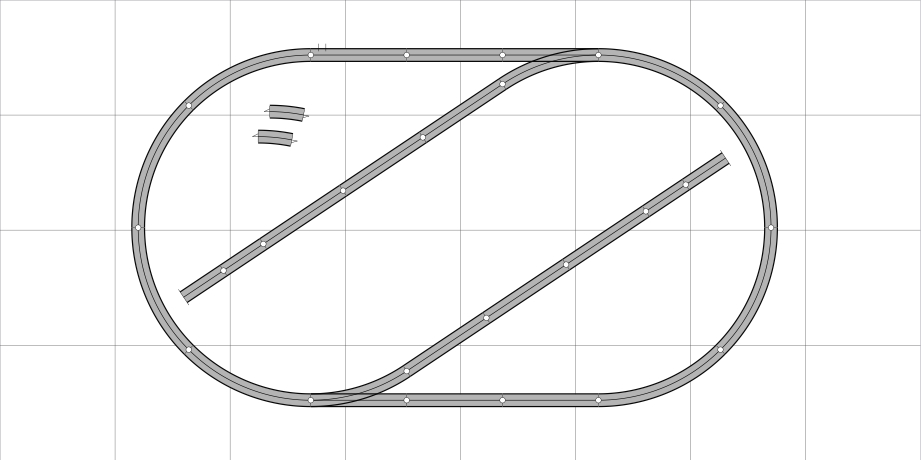
Figure 3: 2 inside sidings
Track
6-12014, 0 Lionel FasTrack, Straight 10″ 9 pieces
6-12015, 0 Lionel FasTrack, Curve 18″, angle 45º (O36) 8 pieces
6-12016, 0 Lionel FasTrack, Terminal section 10″ 1 piece
6-12024, 0 Lionel FasTrack, Straight 5″ 2 pieces
6-12035, 0 Lionel FasTrack, Buffer/Bumper (Light) 5″ 2 pieces
6-81947, 0 Lionel FasTrack, Left turnout 10″. (O36) Remote/Command 2 pieces
6-12023, 0 Lionel FasTrack, Curve 18″, angle 11.25º (O36) 2*
* Supplied with the turnout, not used.
However, if switching is not your game, or, if you like to run passenger trains with long cars, another option is to stretch the starter oval to the extremes of the 4 x 8 foot layout table, to give them room to run (figure 4a). This would only require the addition of six 10 inch straights and two five-inch straights on the long side.
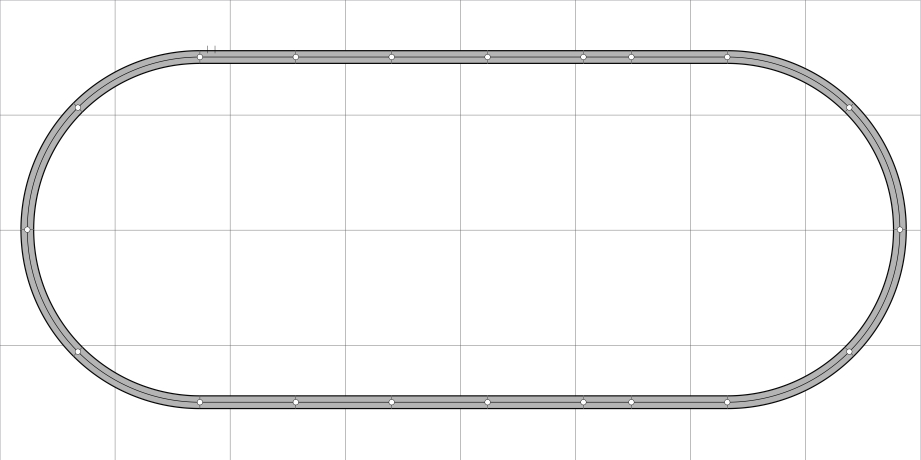
Figure 4a: starter loop stretch
Track
6-12014, 0 Lionel FasTrack, Straight 10″ 9 pieces
6-12015, 0 Lionel FasTrack, Curve 18″, angle 45º (O36) 8 pieces
6-12016, 0 Lionel FasTrack, Terminal section 10″ 1 piece
6-12024, 0 Lionel FasTrack, Straight 5″ 2 pieces
If you don’t mind running the trains close to the edge of the table, you could also add a five-inch straight in the middle of the curved tracks on each end (figure 4B).
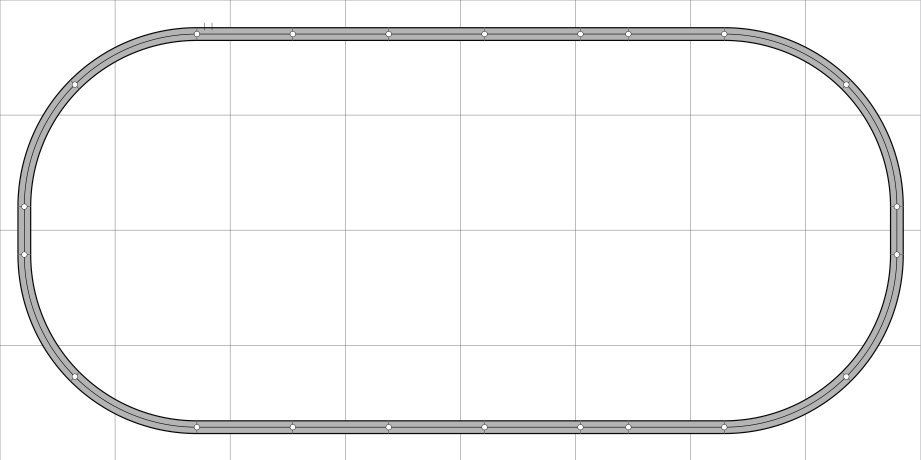
Figure 4B: 5 inch ends:
Track
6-12014, 0 Lionel FasTrack, Straight 10″ 9 pieces
6-12015, 0 Lionel FasTrack, Curve 18″, angle 45º (O36) 8 pieces
6-12016, 0 Lionel FasTrack, Terminal section 10″ 1 pieces
6-12024, 0 Lionel FasTrack, Straight 5″ 4 pieces
Theoretically, you could substitute 10inch straights in the middle of the curves (figure 4c), but that would bring the trains right to the edge of the table and any derailment might send equipment tumbling to the floor.

Figure 4C: 10 Inch Ends
Track
6-12014, 0 Lionel FasTrack, Straight 10″ 11 pieces
6-12015, 0 Lionel FasTrack, Curve 18″, angle 45º (O36) 8 pieces
6-12016, 0 Lionel FasTrack, Terminal section 10″ 1 pieces
6-12024, 0 Lionel FasTrack, Straight 5″ 2 pieces
Skipping the tracks added into the curves in figures 4B and 4C, you still have opened up a lot of real estate inside of your loop. Figure 5 shows how much longer your inside sidings can be with a stretched loop.

Figure 5: 2 inside siding stretch
Track
6-12014, 0 Lionel FasTrack, Straight 10″ 15 pieces
6-12015, 0 Lionel FasTrack, Curve 18″, angle 45º (O36) 8 pieces
6-12016, 0 Lionel FasTrack, Terminal section 10″. 1 piece
6-12024, 0 Lionel FasTrack, Straight 5″ 2 pieces
6-12035, 0 Lionel FasTrack, Buffer/Bumper (Light) 5″ 2 pieces
6-81947, 0 Lionel FasTrack, Left turnout 10″ (O36) Remote/Command 2 pieces
6-12023, 0 Lionel FasTrack, Curve 18″, angle 11.25º (O36) 2*
Supplied with the turnouts but not used
This stretched loop offers a lot of options for inside sidings, and you could go completely off the deep end with Figure 6: Switch Crazy. In this layout, the four separate sidings at the top could each be a different industry to service, and the siding with four legs at the bottom could be a little yard to station cars that are not currently in use. The very top extension could even be a place to park a small yard engine used to jockey cars around in the yard.
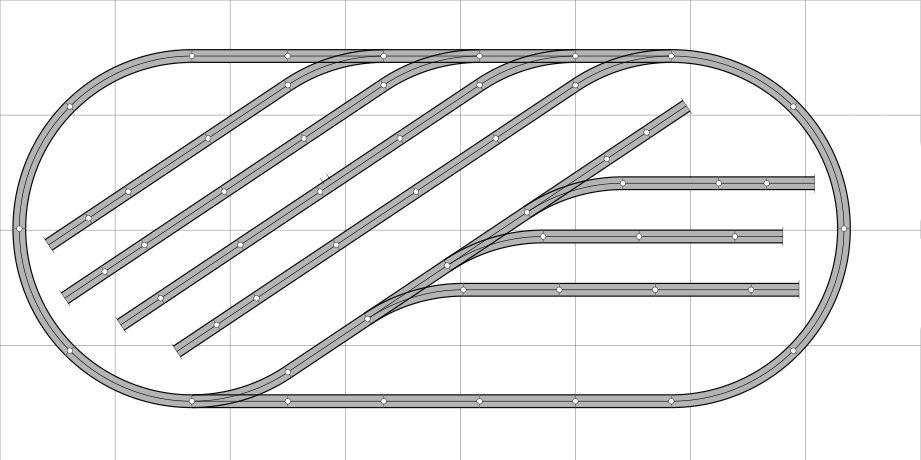
Figure 6: Switch Crazy
Track
6-12014, 0 Lionel FasTrack, Straight 10″ 24 pieces
6-12015, 0 Lionel FasTrack, Curve 18″, angle 45º (O36) 8 pieces
6-12016, 0 Lionel FasTrack, Terminal section 10″ 1 pieces
6-12024, 0 Lionel FasTrack, Straight 5″ 5 pieces
6-12035, 0 Lionel FasTrack, Buffer/Bumper (Light) 5″ 8 pieces
6-81946, 0 Lionel FasTrack, Right turnout 10″ (O36) Remote/Command 3 pieces
6-81947, 0 Lionel FasTrack, Left turnout 10″ (O36) Remote/Command 5 pieces
Another option to stretching the starter loop is to use the real estate outside of the loop for an outside siding. In figure 7, the siding is so long it can now we can use it as a branch line that supplies raw materials such as coal to the mainline railroad. The inside siding could be where the branch line drops its cars for the mainline to pick up. That would mean the top part of the mainline loop would be interchange trackage that both the mainline and branch line shared, so use of that part of the loop would have to be scheduled to avoid disaster.
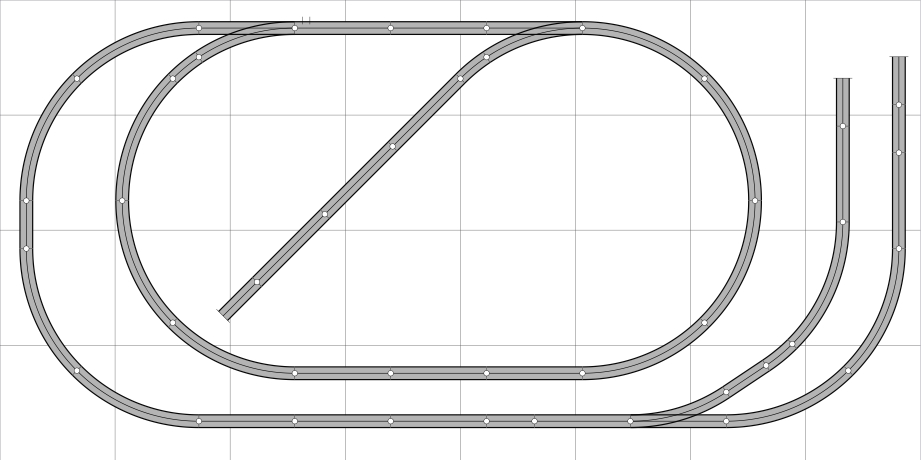
Figure 7: inside and outside sidings
Track
6-12014, 0 Lionel FasTrack, Straight 10″ 13 pieces
6-12015, 0 Lionel FasTrack, Curve 18″, angle 45º (O36) 14 pieces
6-12016, 0 Lionel FasTrack, Terminal section 10″ 1 pieces
6-12023, 0 Lionel FasTrack, Curve 18″, angle 11.25º (O36) 3 pieces
6-12024, 0 Lionel FasTrack, Straight 5″ 4 pieces
6-12035, 0 Lionel FasTrack, Buffer/Bumper (Light) 5″ 3 pieces
6-81947, 0 Lionel FasTrack, Left turnout 10″ (O36) Remote/Command 3 pieces
Figure 8 takes that operation one step further, with a lower inside siding that crosses over the top inside siding. This adds complexity to spotting cars on the siding, so as not to block one siding or the other. Also, to use the bottom inside siding, a branch line locomotive would have to drop the car on the mainline, and run around the entire loop to get behind the car and push it into the siding. This would require any mainline locomotives to park on the other siding to clear the mainline for this maneuver.

Figure 8: 2 inside 1 outside siding
Track
6-12014, 0 Lionel FasTrack, Straight 10″ 13 pieces
6-12015, 0 Lionel FasTrack, Curve 18″, angle 45º (O36) 14 pieces
6-12016, 0 Lionel FasTrack, Terminal section 10″ 1 pieces
6-12019, 0 Lionel FasTrack, Crossing 6″ 90º 1 piece
6-12023, 0 Lionel FasTrack, Curve 18″, angle 11.25º (O36) 4 pieces
6-12024, 0 Lionel FasTrack, Straight 5″ 6 pieces
6-12035, 0 Lionel FasTrack, Buffer/Bumper (Light) 5″ 4 pieces
6-81946, 0 Lionel FasTrack, Right turnout 10″ (O36) Remote/Command 1 pieces6-81947, 0 Lionel FasTrack, Left turnout 10″ (O36) Remote/Command 3 pieces
Lionel Trains on eBay (we may earn a commission from products purchased)
As long as we are talking about multiple train operation, let’s talk about the difference between a “stub siding” and a “passing siding.” What I have been referring to as a “siding” is more accurately a “stub siding,” as it has just one junction with the mainline. It can be used as a passing siding if it is long enough for an entire train to use it to clear the mainline while another train passes it. However, “passing sidings” normally have a junction at each end with the mainline, so the train using it doesn’t have to back up, it merely exits the mainline onto the siding, and when the mainline is clear, it reenters it through the second junction.
For example, look at figure 9, in which the stretched parts of the loop are added on to the original loop using turnouts. Now you can have two trains that share the mainline as one can use the passing siding while the other utilizes the mainline.

Figure 9: starter loop stretch, 2 outside passing sidings
Track
6-12014, 0 Lionel FasTrack, Straight 10″ 4 pieces
6-12015, 0 Lionel FasTrack, Curve 18″, angle 45º (O36) 12 pieces
6-12023, 0 Lionel FasTrack, Curve 18″, angle 11.25º (O36) 4 pieces
6-12024, 0 Lionel FasTrack, Straight 5″ 4 pieces
6-81946, 0 Lionel FasTrack, Right turnout 10″ (O36) Remote/Command 2 pieces
6-81947, 0 Lionel FasTrack, Left turnout 10″ (O36) Remote/Command 2 pieces
If you want to have two trains running at the same time, you can do as we have in figure 10 and add a second loop of track around the original loop, using 4.5 inch and 1.75 inch straight tracks to make the outer loop wide enough to encircle the inner loop.
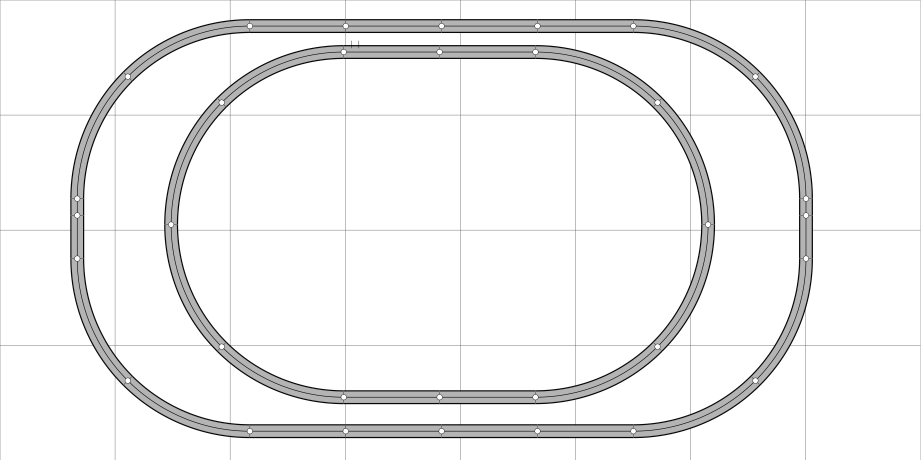
Figure 10:two loops
Track
6-12014, 0 Lionel FasTrack, Straight 10″ 11 pieces
6-12015, 0 Lionel FasTrack, Curve 18″, angle 45º (O36) 16 pieces
6-12016, 0 Lionel FasTrack, Terminal section 10″ 1 piece
6-12025, 0 Lionel FasTrack, Straight 4.5″ 2 pieces
6-12026, 0 Lionel FasTrack, Straight 1.75″ 2 pieces
Having two loops allows you to have two different railroads operating on one layout, and you could create a transfer depot where cargo is unloaded from one railroad and loaded onto the other, but this is inefficient and costs a lot in man-hours of labor to accomplish. Most mainline railroads have an interchange with other mainline railroads such as we demonstrated with the branch line in Figures 7 and 8, but on a larger scale. At first glance figure 11 looks like three concentric loops of track. But on closer examination, there are only two complete loops, and the third loop is simple two interchange tracks on which one mainline railroad could “spot” cars for the other mainline railroad to pick up. There are also two inside sidings which the outer railroad could be granted trackage rights to spot cars there, or more likely the inner railroad line would pick them up from the interchange tracks and spot them. The interesting thing about this layout is that any train entering the interchange track from the inside loop can move onto the outer loop, and vice versa. So if you have very cooperative mainline railroads, the interchange tracks become passing sidings that a train from the outside loop can use to clear the tracks for a train from the inside loop to use.
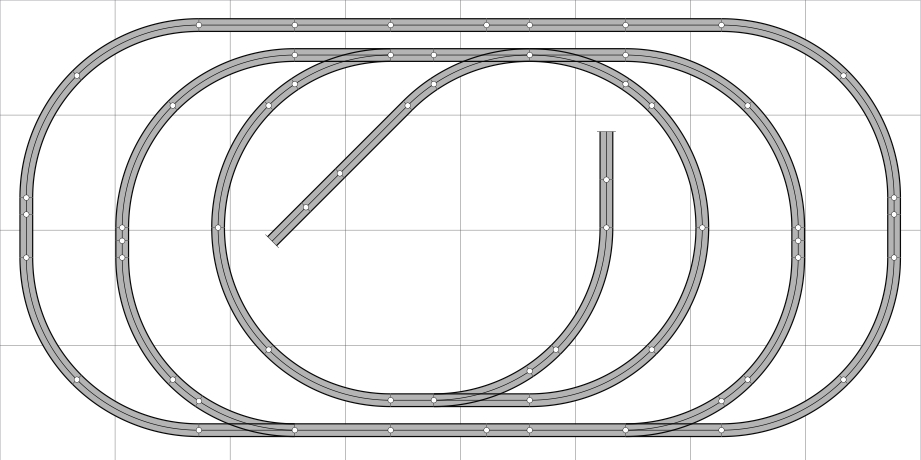
Figure 11: two loops connected
Track
6-12014, 0 Lionel FasTrack, Straight 10″ 9 pieces
6-12015, 0 Lionel FasTrack, Curve 18″, angle 45º (O36) 21 pieces
6-12023, 0 Lionel FasTrack, Curve 18″, angle 11.25º (O36) 6 pieces
6-12024, 0 Lionel FasTrack, Straight 5″ 2 pieces
6-12025, 0 Lionel FasTrack, Straight 4.5″ 6 pieces
6-12026, 0 Lionel FasTrack, Straight 1.75″ 4 pieces
6-12073, 0 Lionel FasTrack, Straight 1.37″ 2 pieces
6-12035, 0 Lionel FasTrack, Buffer/Bumper (Light) 5″ 2 pieces
6-81946, 0 Lionel FasTrack, Right turnout 10″. (O36) Remote/Command 2 pieces
6-81947, 0 Lionel FasTrack, Left turnout 10″. (O36) Remote/Command 4
So don’t get stuck chasing your tail around an oval of track. Use these plans or your own imagination to create an entire railroad on a 4′ x 8′ sheet of plywood!
Lionel FasTrack on eBay (we may earn a commission from products purchased)